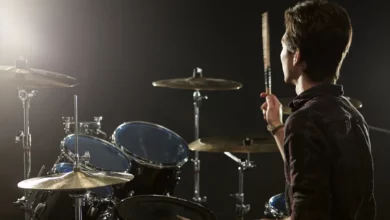
We may earn a commission from the affiliate links on this site. Learn more›
Timpani, otherwise known as kettle drums, are standard in middle school and high school repertoire for band classes.
Initially, a pair of timpani was sufficient, but in almost all cases today, at least four drums are used.
Timpani Playing Ranges
The given range of a set of timpani drums depends on whether or not they have extended or non-extended collars.
- Non-extended collar drums — 1″ larger heads than the diameter, counterhoop/rim is next to the bowl
- Extended collar drums — 2″ larger heads than the diameter, counterhoop/rim is about 1″ away from the bowl
For example, a 27″ timpani head should fit on a 26″ regular collar drum.
Be sure to either ask your teacher (if you’re in school) or refer to the manufacturer if you’re unsure which type of drums you own.
While the heads used are different sizes, the pitches the drums output can also vary.
The chart below shows the difference in tuning ranges between the two types of drums.
Click here to see a larger version of the infographic. Feel free to use it on your own site, if you’d like. Please link back to Drumming Review.
As seen above, the non-extended collar variant of the lowest drum reaches D2, while the extended can go low as C2.
What Notes Sound “Good?”
The range on paper is one thing, but the tone is another. Just because a 26″ drum can play a Bb2, it won’t necessarily sound the greatest since it’s the lowest pitch the drum can output.
In that example, you should strive to play the Bb2 on the 29″ drum, as the skin has more tension and a fuller, warmer sound.
Tuning Timpani Drums to Their Range
When tuning, set the correct range by matching the lowest note according to the drum.
If your timpani is out of range, your pedal may slip and will not hold pitch properly. In some cases, the head will stretch too much and lose resilience quicker.
Any timpani heads with dents or tears need replacement — they will not hold a pitch generally.
Four Timpani Drum Configuration
The standard set of timpani kettle drums consists of four graduated sizes:
- 32″
- 29″
- 26″
- 23″
The sizes listed are generalized, as timpani drums aren’t always standard.
Five Timpani Drums Configuration
In some cases, there is a need for a fifth drum.
The sizes of the lower drums remain the same. Depending on taste, there is an addition of either a 20″ or 21″ drum.
The 21″ timpani is far less common in the United States. I suspect unusual sizes only exist in professional orchestras.
Whether to use the 20″ or 21″ is a continual and subjective debate between players.
Pitches above C4 tend to sound fuller and warmer on a 21″ drum. Former principal percussionist Gordon Peters of the Chicago Symphony Orchestra notes in his book, The Drummer: Man, that he favors the 21″ drum, noting a higher degree of flexibility.
Other Sized Timpani Drums
For the high school setting, students only have access to the 23″ and sometimes, the 20″ kettle drum, but there are even smaller drums reserved for professional orchestras.
According to PAS, there are specially sized drums that are small as 14″ and 15″ respectively. I scoured the internet for photos of the instruments but had no luck (if you do, I would love to see them. Please share!).
And, for the 808 fans out there, there’s even a 70″ drum (I can’t believe I’m writing this).
You read right — a 70″ timpani drum. Jonathan Haas built the world’s biggest kettle drum, which produces a B flat two octaves below the lowest C on any existing timpani.
There’s no practical use for this size of a drum, but hey, it’s interesting nonetheless.
Changing Heads on Timpani Drums
The collar of the drum usually poses an issue, so it’s best always to measure the outside diameter of the old head if you’re changing.
Regular collars feature heads that are 1″ larger than the drum’s diameter. Extended collars have heads 2″ larger.
As stated before, be sure to measure if you’re unsure. Drum heads for kettle drums aren’t the cheapest.
If you don’t have access to the old heads anymore, check out this excellent guide put together by the team at Lonestar Percussion on replacing timpani heads.



